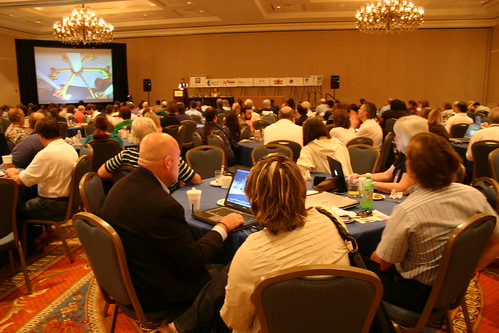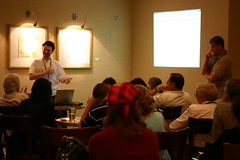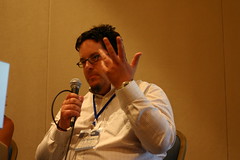The three day Second Life Community Convention from September 5-7, 2008 in Tampa, Florida firmly made the case that some of the most vital and innovative work in the virtual world is being done by the education sector. With 400 some real world participants (plus others beaming in virtually) converging on the grand Marriott Waterside Hotel, the most organized constituency present was clearly the educators and academics. Breaking out from the track format, the education sector organized their own semi-autonomous Second Life Education Community Conference (SLEDcc) which extended the conference an extra day than it was originally slated to run.
All of the keynotes at the SLCC were organized by the education sector
— Intellagirl Tulley speaking on the first day, Barry Joseph of Global
Kids on the second, and Beyers Sellers of Cornell giving the final
keynote.
Best Practices and case studies were described by various educational
institutions like Eye4U Alliance, Rockcliffe University and Globl Kids.
There was a “SLED Sparks” session, similar to an academic Poster
Session, that allowed several emerging scholars in this field to
present their work in “20 slides in 2 minutes.” And specific tools
were demoed like SLOODLE, the free GK Second Life curriculum, and
Multitalker.
On Sunday, there was a feedback session on “What would Educators Like
to See in the Next 1-3 Year Time Frame?” where educators were able to
vent their problems and suggestions to Claudia Linden.
Meanwhile, many of the most prominent Second Life commercial developers
and companies were absent, such as the Electric Sheep Company, Anshe
Chung Studios, Rivers Run Red, and Millions of Us. With the exception
of SLCN and SL NEXT, Second Life media were no where to be seen, from
New World Notes, to the SL Herald, Massively, and the Metaverse
Messenger. And no real world media were present.
I was not present at many of the other tracks — from Real Estate to
Health, Open Source and TV/Film — but attendance and energy seemed
quite down in these tracks compared to last year overall. The
non-profit track, which I participated in, was definitely much more
modest than Chicago, with just a handful of speakers and an audience of
only a dozen or so participants.
Linden Lab appeared to be present in force, with Lindens present in
almost every workshop I attended. Both Philip Rosedale and Mark
Kingdon were walking the hallways and chatted with residents during one
breakfast session.
Stroker Serpentine’s party, Strokerz Ball, remained a naughty
spectacle, but it lacked a certain critical mass and energy that was
evident last year. There were maybe two furries in attendance, which I
found kind of sad.
International and youth participation seemed very down from previous
years. There were no Teen Second Life residents present as far as I
know, which given the timing – early September – is not much of a
surprise. I met some folks from the Dominican Republic, plus Starr
Sonic from Australia, Daniel Livingstone from the UK, Kevin Feenan from
Canada, and that’s about it for the non-Americans I encountered.
All told, it was a very useful and stimulating conference for me
personally. I had a blast meeting and jawboning with old and new
friends in SL, connecting with potential partners and allies for our
work at Global Kids, and filling my head with new ideas and approaches
to our work.
But is SLCC a barometer for the health of Second Life as a platform and
a community? I think it’s clear that we’re no longer in a rapid growth
period. Business is down, that is for sure. Education appears to be
healthy and growing. But as Barry Joseph asks, can Second Life still
tip into the common culture? The answer is far from clear.




Actually, we have a Massively staffer in Tampa, but she’s down with a very, very bad case of the con-plague from the last convention she covered, and we’re hoping she’ll get better soon. She’s really quite extraordinarily ill.
You wouldn’t have thanked us if we’d sent her and she’d infected everyone. Seriously.
As for myself, I really can’t fly anywhere anymore (it’s my heart condition – have a few cardiac arrests on aircraft, and see how much fun that is for everyone. Hint: less than none at all), so I’m limited to surface transport.
Granted, we’ve missed what is probably our one chance each year to actually have any Linden Lab employee to talk to us, which is kind of sad. And we’d have liked to have met you all, since so many people at SLCC (and at Linden Lab) are avid readers.
These things just don’t always work out. Getting together in virtual environments is a whole lot easier, in my experience. Though there’s considerably less hugging.
Sorry about your staffer, Tateru. That really sucks.
I would have loved to meet you and to get your perspective on the proceedings, but not at the expense of a cardiac arrest!
Best regards, rik
Nice post, Rik. I like the pix.
The education track was actually lighter than Chicago when we had a peak concurrency of 240. The good news is the HUGE growth in this sector at major .edu conferences:
http://emergingonlinelearningtechnology.org/
http://www.arvelsig.com/
http://tinyurl.com/isteinsl/
http://tinyurl.com/educauseinsl
It seems like SLCC is shaping into a fun ad hoc event while the serious professional efforts are shifting elsewhere. This could be the “Vida Ludic” show where old friends get together to compare their newest tricks. Does that make a show with lasting power? The jury is out.
–Jeremy Kemp
Don’t have the details but heard that Pheonix Psaltry, the Metaverse Messenger publisher has been unwell – they were planning to have print edition at Tampa.